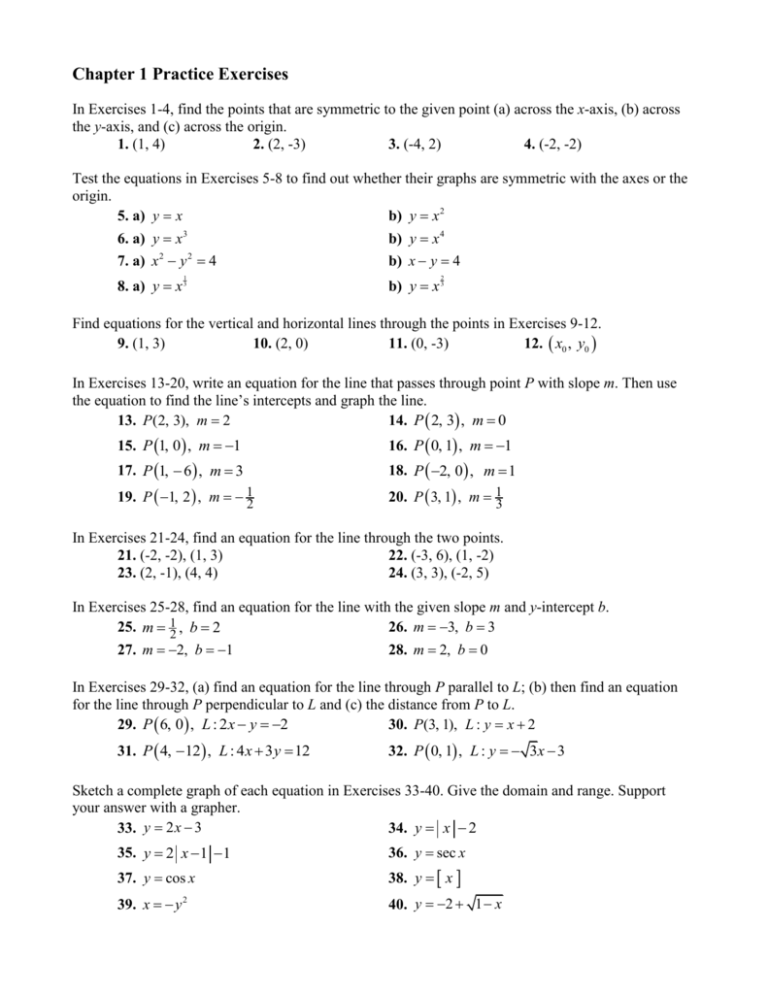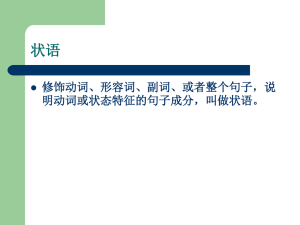Chapter 1 Practice Exercises
advertisement

Chapter 1 Practice Exercises In Exercises 1-4, find the points that are symmetric to the given point (a) across the x-axis, (b) across the y-axis, and (c) across the origin. 1. (1, 4) 2. (2, -3) 3. (-4, 2) 4. (-2, -2) Test the equations in Exercises 5-8 to find out whether their graphs are symmetric with the axes or the origin. 5. a) y x b) y x 2 6. a) y x 3 b) y x 4 7. a) x 2 y 2 4 b) x y 4 1 8. a) y x 3 2 b) y x 3 Find equations for the vertical and horizontal lines through the points in Exercises 9-12. 9. (1, 3) 10. (2, 0) 11. (0, -3) 12. x0 , y0 In Exercises 13-20, write an equation for the line that passes through point P with slope m. Then use the equation to find the line’s intercepts and graph the line. 13. P(2, 3), m 2 14. P 2, 3 , m 0 15. P 1, 0 , m 1 16. P 0, 1 , m 1 17. P 1, 6 , m 3 18. P 2, 0 , m 1 19. P 1, 2 , m 12 20. P 3, 1 , m 13 In Exercises 21-24, find an equation for the line through the two points. 21. (-2, -2), (1, 3) 22. (-3, 6), (1, -2) 23. (2, -1), (4, 4) 24. (3, 3), (-2, 5) In Exercises 25-28, find an equation for the line with the given slope m and y-intercept b. 25. m 12 , b 2 26. m 3, b 3 27. m 2, b 1 28. m 2, b 0 In Exercises 29-32, (a) find an equation for the line through P parallel to L; (b) then find an equation for the line through P perpendicular to L and (c) the distance from P to L. 29. P 6, 0 , L : 2 x y 2 30. P(3, 1), L : y x 2 31. P 4, 12 , L : 4 x 3 y 12 32. P 0, 1 , L : y 3x 3 Sketch a complete graph of each equation in Exercises 33-40. Give the domain and range. Support your answer with a grapher. 33. y 2 x 3 34. y x 2 35. y 2 x 1 1 36. y sec x 37. y cos x 38. y x 39. x y 2 40. y 2 1 x Find the domain and range and draw a complete graph of each function in Exercises 41-46. 41. f x x3 8x2 x 37 42. f x 1 3 1 x 43. f x log7 x 1 1 44. f x 32 x 1 45. f x x 2 x 3 46. f x x2 x2 In Exercises 47-50, describe how the graph of f can be obtained from the graph of g. 3 47. f x 2 x 1 5, g x x3 48. f x 2ln x 1 3, g x ln x 49. f x 3sin 3x , g x sin x 50. f x 2 4 3 x 5, g x 4 x Exercises 51-54 specify the order in which transformations are to be applied to the graph of the given equation. Give an equation for the transformed graph in each case. 51. y x 2 , vertical stretch by 2, reflect through x-axis, shift right 2, shift up 3 52. x y 2 , horizontal shrink by 0.5, reflect through y-axis, shift left 3, shift down 2 53. y 1x , vertical stretch by 3, shift left 2, shift up 5 54. x 2 y 2 1, shift left 3, shift up 5 A complete graph of f is shown. Sketch a complete graph of each function in Exercises 55-58. 5 55. y f x 56. y f x y 4 57. y 2 f x 1 1 3 2 58. y 3 f x 2 2 1 –4 –3 –2 –1 1 2 –1 Determine the vertex and axis of symmetry and sketch a complete graph of each parabola in Exercises 59-60. Support your work with a grapher. 59. y x 2 4 x 1 60. x 2 y 2 8 y 3 In Exercises 61-66, say whether each function is even, odd, or neither. 61. a) y cos x b) y cos x 62. a) y sin x b) y sin x c) y 1 cos x c) y 1 sin x 63. a) y x 2 1 b) y x c) y x x 2 1 64. a) y x 3 65. a) y sec x 66. a) y csc x b) y x b) y tan x b) y cot x c) y x 4 c) y sec x tan x c) y csc x cot x 67. Graph the function y x x . Is the function periodic? If so, what is the period? x 68. Graph the function y x x . Is the function periodic? If so, what is the period? Graph the functions in Exercises 69-72. x , 4 x 0 69. y x , 0 x 4 x 2, 2 x 1 70. y x, 1 x 1 x 2, 1 x 2 sin x, 0 x 2 71. y 0, 2 x cos x, 0 x 2 72. y 0, 2 x Write formulas for the piecewise functions graphed in Exercises 73 and 74. y y 73. 74. (2, 5) 2 5 1 1 2 x 4 x In Exercises 75 and 76, find the domains and ranges of f , g , f g , f g , f / g , g / f . Also, find the domains and ranges of the composites f g and g f . 75. f x 1x , g x 1 x 76. f x x , g x 1 x In Exercises 77-80, write an equation for the circle with the given center (h, k) and radius a. 77. (h, k) = (1, 1), a = 1 78. (h, k) = (2, 0), a = 5 1 79. (h, k) = (2, -3), a = 2 80. (h, k) = (-3, 0), a = 3 In Exercises 81-84 identify the centers and radii of the circles. 2 2 2 81. x 3 y 5 16 82. x 2 y 5 2 83. x 2 y 2 2 x 14 y 71 84. x 2 y 2 8x 2 y 64 In Exercises 85 and 86 use inequalities to describe the regions. 85. a) The interior of the circle of radius 1 centered at the origin. b) The region consisting of the circle and its interior. 86) a) The exterior of the circle of radius 2 centered at the point (1, 1). b) The region consisting of the circle and its exterior. Solve the equations in Exercises 87-90 algebraically. Support your answer with a grapher. 87. x 1 12 88. 2 3x 1 89. 25x 1 7 90. 52 x 7 Describe the intervals in Exercises 91-94 with inequalities that do not involve absolute values. 91. x 2 12 92. 2 x 7 3 y 93. y 52 53 94. 8 2 1 Solve the equations in Exercises 95-98. 95. x3 7 x 2 12 x 2 0 97. 2 log3 x 2 log3 3 x 0 96. 4 x3 10 x 2 9 0 98. sin x 0.7 Solve the inequalities in Exercises 99-102 algebraically. Support your answer graphically. 1 99. 1 2 x 3 100. 2 x 5 1 102. 2 3x 1 101. x3 2 1 Solve the inequalities in Exercises 103 and 104. 103. x3 7 x 2 12 x 2 (See Exercise 95.) 104. 4 x3 10 x 2 9 0 (See Exercise 96.) 105. Change from degrees to radians: a) 30º b) 22º c) –130º d) –150º 106. Change from radians to degrees: a) 32 b) –0.9 c) 2.75 d) 54 Find the sine, cosine, tangent, cotangent, secant, and cosecant of each angle in Exercises 107 and 108. The angles are given in radian measure. 107. a) 1.1 b) –1.1 c) 23 d) – 23 108. a) b) – c) 2.7 d) –2.7 4 4 109. Graph the following functions on the same set of axes over the interval 0 x 2 . a) y cos 2 x b) y 1 cos 2 x c) y cos 2 x 110. Graph the following functions on the same set of axes over the interval 0 x 2 . a) y cos 2 x b) y cos 2 x c) y 1 cos 2 x d) y sin 2 x 111. Find cos 2 6 a) by finding cos 6 and squaring. b) by using a Double-Angle formula. 112. Find sin 2 4 a) by find sin 4 and squaring. b) by using a Double-Angle formula. In Exercises 113 and 114, find f 1 x , and show that f f 1 x f 1 x f x x . Draw a complete graph of f and f 1 in the same viewing window. 113. f x 2 3x 114. f x x 2 , x 2 2 Draw a graph of the inverse relation of each function in Exercises 115 and 116. Is the inverse relation a function? 115. y x3 x 116. y xx12 Give the measure of the angles in Exercises 117 and 118 in radians and degrees. 117. sin 1 0.7 118. tan 1 2.3 Draw complete graphs of the functions in Exercises 119-122. Explain why your graphs are complete. 119. y cos x 121. y cos x cos x 2 cos x cos x 2 cos x cos x 122. y 2 120. y 123. A 100-in. piece of wire is cut into two pieces. Each piece of wire is used to make a square wire frame. Let x be the length of one piece of the wire. a) Determine an algebraic representation A(x) for the total area of the two squares. b) Draw a complete graph of y A x . c) What are the domain and range of A x ? d) What values of x make sense in the problem situation? Which portion of the graph in part (b) is a graph of the problem situation? e) Use a graph to determine the length of the two pieces of wire if the total area is 400 in.2 Confirm your answer algebraically. f) Use a graph to determine the length of the two pieces of wire if the total area is a maximum. 124. Equal squares of side length x are removed from each corner of a 20- by 30-in. piece of cardboard, and the sides are turned up to form a box with no top. a) Write the volume V of the box as a function of x. b) Draw a complete graph of y V x . c) What are the domain and range of y V x ? d) What values of x make sense in the problem situation? Draw a graph of the problem situation. e) Use ZOOM-IN to determine x so that the box has maximum volume. What is the maximum volume? f) Use a graph to determine the dimensions of a box with volume 750 in.3 125. Draw a complete graph of the equation x y 1 .







